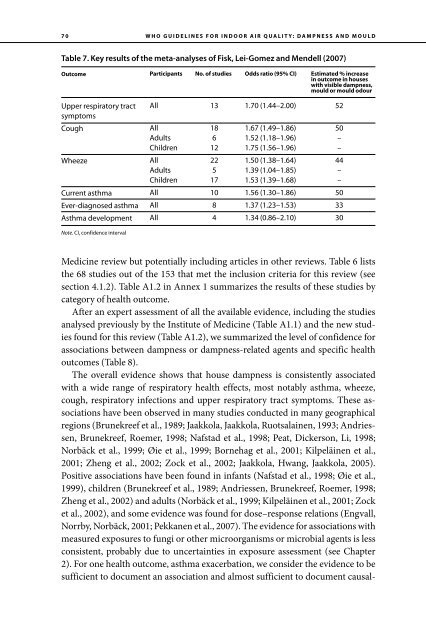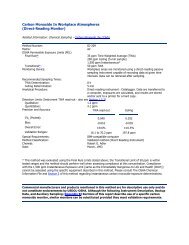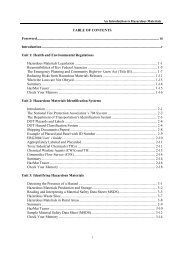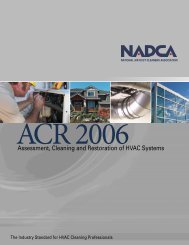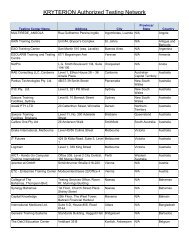Dampness and Mould - WHO guidelines for indoor air quality - PRWeb
Dampness and Mould - WHO guidelines for indoor air quality - PRWeb
Dampness and Mould - WHO guidelines for indoor air quality - PRWeb
Create successful ePaper yourself
Turn your PDF publications into a flip-book with our unique Google optimized e-Paper software.
70<br />
<strong>WHO</strong> GUIDELINES FOR INDOOR AIR QUALITY: DAMPNESS AND MOULD<br />
Table 7. Key results of the meta-analyses of Fisk, Le i-Gomez <strong>and</strong> Mendell (2007)<br />
Outcome<br />
Participants<br />
No. of studies<br />
Odds ratio (95% CI)<br />
Estimated % increase<br />
in outcome in houses<br />
with visible dampness,<br />
mould or mould odour<br />
Upper respiratory tract<br />
symptoms<br />
Cough<br />
All<br />
13<br />
1.70 (1.44–2.00)<br />
52<br />
Wheeze<br />
Current asthma<br />
Ever-diagnosed asthma<br />
Asthma development<br />
All<br />
Adults<br />
Children<br />
All<br />
Adults<br />
Children<br />
All<br />
All<br />
All<br />
18<br />
6<br />
12<br />
22<br />
5<br />
17<br />
10<br />
8<br />
4<br />
1.67 (1.49–1.86)<br />
1.52 (1.18–1.96)<br />
1.75 (1.56–1.96)<br />
1.50 (1.38–1.64)<br />
1.39 (1.04–1.85)<br />
1.53 (1.39–1.68)<br />
1.56 (1.30–1.86)<br />
1.37 (1.23–1.53)<br />
1.34 (0.86–2.10)<br />
50<br />
–<br />
–<br />
44<br />
–<br />
–<br />
50<br />
33<br />
30<br />
Note. CI, confidence interval<br />
Medicine review but potentially including articles in other reviews. Table 6 lists<br />
the 68 studies out of the 153 that met the inclusion criteria <strong>for</strong> this review (see<br />
section 4.1.2). Table A1.2 in Annex 1 summarizes the results of these studies by<br />
category of health outcome.<br />
After an expert assessment of all the available evidence, including the studies<br />
analysed previously by the Institute of Medicine (Table A1.1) <strong>and</strong> the new studies<br />
found <strong>for</strong> this review (Table A1.2), we summarized the level of confidence <strong>for</strong><br />
associations between dampness or dampness-related agents <strong>and</strong> specific health<br />
outcomes (Table 8).<br />
The overall evidence shows that house dampness is consistently associated<br />
with a wide range of respiratory health effects, most notably asthma, wheeze,<br />
cough, respiratory infections <strong>and</strong> upper respiratory tract symptoms. These associations<br />
have been observed in many studies conducted in many geographical<br />
regions (Brunekreef et al., 1989; Jaakkola, Jaakkola, Ruotsalainen, 1993; Andriessen,<br />
Brunekreef, Roemer, 1998; Nafstad et al., 1998; Peat, Dickerson, Li, 1998;<br />
Norbäck et al., 1999; Øie et al., 1999; Bornehag et al., 2001; Kilpeläinen et al.,<br />
2001; Zheng et al., 2002; Zock et al., 2002; Jaakkola, Hwang, Jaakkola, 2005).<br />
Positive associations have been found in infants (Nafstad et al., 1998; Øie et al.,<br />
1999), children (Brunekreef et al., 1989; Andriessen, Brunekreef, Roemer, 1998;<br />
Zheng et al., 2002) <strong>and</strong> adults (Norbäck et al., 1999; Kilpeläinen et al., 2001; Zock<br />
et al., 2002), <strong>and</strong> some evidence was found <strong>for</strong> dose–response relations (Engvall,<br />
Norrby, Norbäck, 2001; Pekkanen et al., 2007). The evidence <strong>for</strong> associations with<br />
measured exposures to fungi or other microorganisms or microbial agents is less<br />
consistent, probably due to uncertainties in exposure assessment (see Chapter<br />
2). For one health outcome, asthma exacerbation, we consider the evidence to be<br />
sufficient to document an association <strong>and</strong> almost sufficient to document causal-


